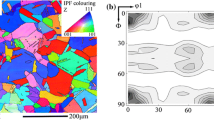Abstract
Equal-channel angular pressing is an effective tool for attaining ultrafine grain sizes in bulk materials. An important advantage of this technique over conventional metalworking processes, such as extrusion and rolling, is that very high strains may be attained without any concomitant change in the cross-sectional dimensions of the sample. The microstructures introduced by equalchannel angular pressing critically depend on a number of experimental factors, including the nature of the slip systems introduced during the pressing operation and the total strain imposed on the sample. These factors are illustrated by reference to experiments conducted on pure aluminum; results are also included to demonstrate the influence of alloying additions and especially the remarkably small grain sizes that may be achieved in materials having low rates of recovery.
Similar content being viewed by others
References
V.V. Stolyarov et al., Nanostruct. Mater., 11 (1999), pp. 947–954.
T.C. Lowe and R.Z. Valiev, JOM, 52 (4) (2000), pp. 27–28.
T.G. Langdon et al., JOM, 50 (6) (1998), pp. 41–45.
K. Nakashima et al., Acta Mater., 46 (1998), pp. 1589–1599.
Y. Iwahashi et al., Scripta Mater., 35 (1996), pp. 143–146.
Y. Wu and I. Baker, Scripta Mater., 37 (1997), pp. 437–441.
A. Shan et al., Scripta Mater., 41 (1999), pp. 353–357.
V.M. Segal, Mater. Sci. Eng., A197 (1995), pp. 157–164.
V.M. Segal, Mater. Sci. Eng., A271 (1999), pp. 322–333.
M. Furukawa et al., Mater. Sci. Eng., A257 (1998), pp. 328–332.
Y. Iwahashi et al., Acta Mater., 46 (1998), pp. 3317–3331.
K. Oh-ishi et al., Metall. Mater. Trans., 29A (1998), pp. 2011–2013.
Y. Iwahashi et al., Acta Mater., 45 (1997), pp. 4733–4741.
Y. Iwahashi et al., Metall. Mater. Trans., 29A (1998), pp. 2245–2252.
P.B. Berbon et al., Mater. Res. Soc. Symp. Proc., 601 (Warrendale, PA: MRS, in press).
S.D. Terhune et al., Proc. Fourth Int. Conf. Recrystallization and Related Phenomena, ed. T. Sakai and H.G. Suzuki (Sendai, Japan: Japan Institute of Metals, 1999), pp. 515–522.
J.K. Mackenzie, Acta Metall., 12 (1964), pp. 223–225.
J. Wang et al., Acta Mater., 44 (1996), pp. 2973–2982.
M. Furukawa et al., Acta Mater., 44 (1996), pp. 4619–4629.
M. Furukawa et al., Acta Mater., 45 (1997), pp. 4751–4757.
S. Ferrasse et al., Metall. Mater. Trans., 28A (1997), pp. 1047–1057.
S. Ferrasse et al., J. Mater. Res., 12 (1997), pp. 1253–1261.
M. Mabuchi, H. Iwasaki, and K. Higashi, Nanostruct. Mater., 8 (1997), pp. 1105–1111.
M. Kawazoe et al., Scripta Mater., 36 (1997), pp. 699–705.
R.Z. Valiev et al., Scripta Mater., 37 (1997), pp. 1945–1950.
T. Mukai, M. Kawazoe, and K. Higashi, Nanostruct. Mater., 10 (1998), pp. 755–765.
M. Furukawa et al., Metall. Mater. Trans., 29A (1998), pp. 169–177.
P.B. Berbon et al., Metall. Mater. Trans., 29A (1998), pp. 2237–2243.
S. Komura et al., Scripta Mater., 38 (1998), pp. 1851–1856.
P.B. Berbon et al., Phil. Mag. Lett., 78 (1998), pp. 313–318.
P.B. Berbon et al., Mater. Trans. JIM, 40 (1999), pp. 772–778.
M. Murayama, K. Hono, and Z. Horita, Mater. Trans. JIM, 40 (1999), pp. 938–941.
F.J. Humphreys et al., Phil. Trans. R. Soc. Lond. A, 357 (1999), pp. 1663–1681.
S. Lee et al., Mater. Sci. Eng., A272 (1999), pp. 63–72.
Y. Iwahashi et al., Metall. Mater. Trans., 29A (1998), pp. 2503–2510.
S. Komura et al., J. Mater. Res., 14 (1999), pp. 4044–4050.
Author information
Authors and Affiliations
Additional information
For more information, contact T.G. Langdon, University of Southern California, Departments of Materials Science and Mechanical Engineering, Los Angeles, California 90089-1453; (213) 740-0491; fax (213) 740-7797; e-mail langdon@usc.edu.
Rights and permissions
About this article
Cite this article
Langdon, T.G., Furukawa, M., Nemoto, M. et al. Using equal-channel angular pressing for refining grain size. JOM 52, 30–33 (2000). https://doi.org/10.1007/s11837-000-0128-7
Issue Date:
DOI: https://doi.org/10.1007/s11837-000-0128-7




